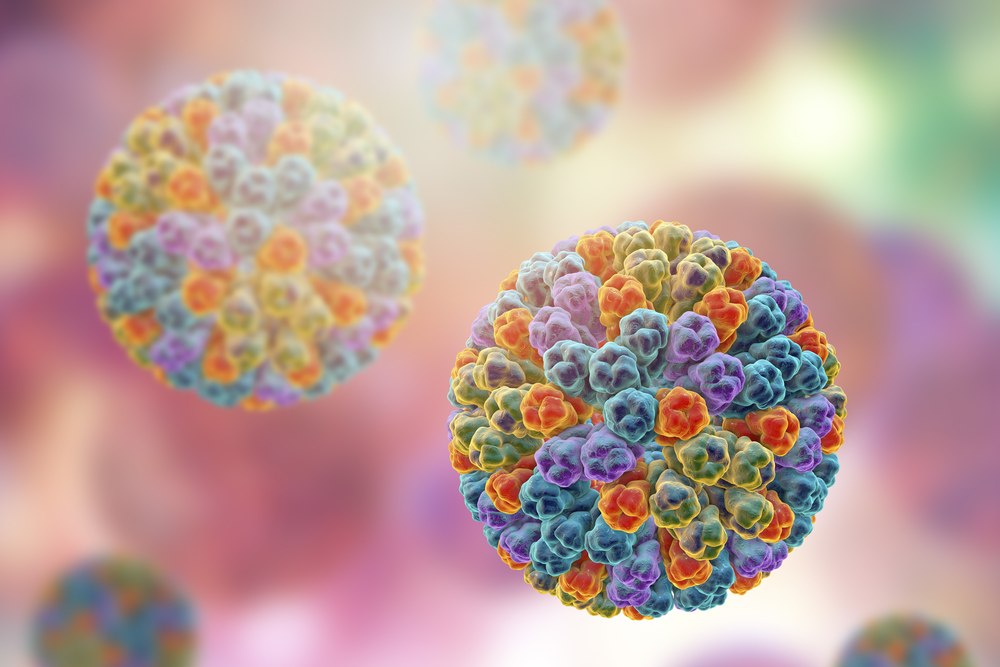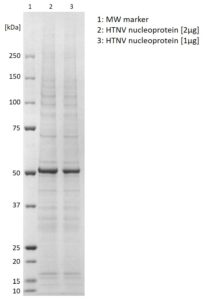SDS-PAGE: Coomassie-stained SDS-PAGE showing purified Hantaan virus (HTNV) Nucleoprotein (N).
Hantaan Virus Nucleoprotein (HEK293), His-Tag
Price range: $683.17 through $2,392.13 excl. VAT
Hantaan Virus Nucleoprotein (HEK293) is a recombinant full-length (1-429) Hantavirus Nucleoprotein (N), expressed in mammalian HEK293 cells and purified as Nucleocapsids.
HANTAAN VIRUS NUCLEOPROTEIN (HEK293), HIS-TAG
Hantaan virus Nucleoprotein (HEK293), His-tag is a recombinant Hantavirus N protein expressed and purified from mammalian cells.
PRODUCT DETAILS – HANTAAN VIRUS NUCLEOPROTEIN (HEK293), HIS-TAG
- Hantaan virus Nucleoprotein (HEK293), His-tag is a recombinant antigen (strain: KY, NCBI Accession Number: ACY79415.1).
- Protein (amino acids 1-429) purified from HEK293 cells as nucleocapsids, using a series of density gradients.
- Nucleoprotein contains a C-terminal 26 amino acid glycine-serine linker with a TEV protease site followed by a 6xHis-tag.
- Presented in phosphate buffered saline (pH7.4) with 0.05% sodium azide.
BACKGROUND
Hantaan orthohantavirus virus is a member of the Hantavirus genus within the Bunyaviridae family of viruses and is a causative agent of a potentially fatal haemorrhagic fever and renal syndrome. Hantavirus genomes have three segments of single stranded negative-sense RNA, named small (S), medium (M) and large (L). The L segment encodes the viral polymerase, the M segment encodes the precursor (GPC) for two viral surface glycoproteins (Gn and Gc), and the S segment encodes the nucleocapsid (N) protein. The hantavirus N plays a pivotal role in viral replication, transcription and assembly (Muyangwa, M).
The Hantaan virus nucleocapsid protein has a molecular weight of ~50kDa and forms a ribonucleoprotein complex which encapsidates genomic RNAs. The Nucleocapsid localises at the perinuclear region of infected or N-expressing cells, forming inclusion bodies and filamentous structures (Yoon, et al., 2015). The nucleoproteins N-terminus contains two coiled-coil motifs that facilitate trimerization to produce putative virus particle assembly intermediates (Alfadhli, et al., 2001). Studies have also demonstrated that in hantavirus-infected cells, N interacts with various cellular host proteins, including Daxx, Ubc and SUMO-1 (Li, et al., 2002; Kaukinen, et al., 2003).
Nucleoproteins are relatively conserved among hantaviruses and are highly immunogenic, having been shown to induce efficient protective immunity in animal models (Carvalho, et al. 2002). The immune responses elicited by NPs are thought to be mainly cellular, as N-specific antibodies have not been shown to be neutralizing. However, specific anti-N antibodies have been shown to induce partial protection in passive immunization experiments with monoclonal antibodies, indicating that N-specific antibodies can contribute to inactivation of hantaviruses through other mechanisms (Carvalho, et al. 2002).
REFERENCES
- Alfadhli, et al. (2001). Hantavirus nucleocapsid protein oligomerization. Journal of Virology, 75(4).
- Carvalho, et al. (2002). Cross-protection against challenge with puumala virus after immunization with nucleocapsid proteins from different hantaviruses. Journal of Virology, 76(13).
- Kaukinen, et al. (2003). Non-covalent interaction between nucleocapsid protein of Tula hantavirus and small ubiquitin-related modifier-1, SUMO-1. Virus Res, 92(1):37-45.
- Li, et al. (2002). Hantavirus nucleocapsid protein interacts with the Fas-mediated apoptosis enhancer Daxx. J Gen Virol, 83(4): 759-766.
- Yoon, et al. (2015). Phosphorylation of the nucleocapsid protein of Hantaan virus by casein kinase II. J Microbiol, 53(5):343-7.


